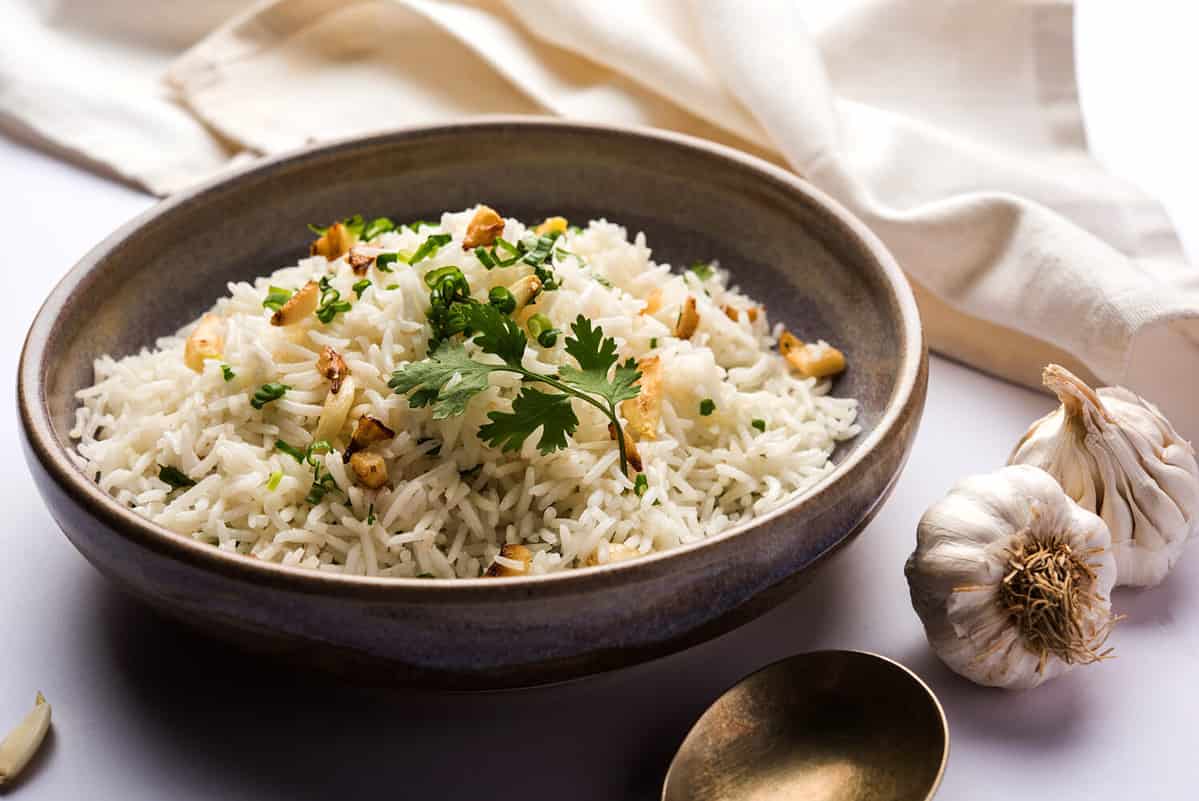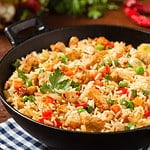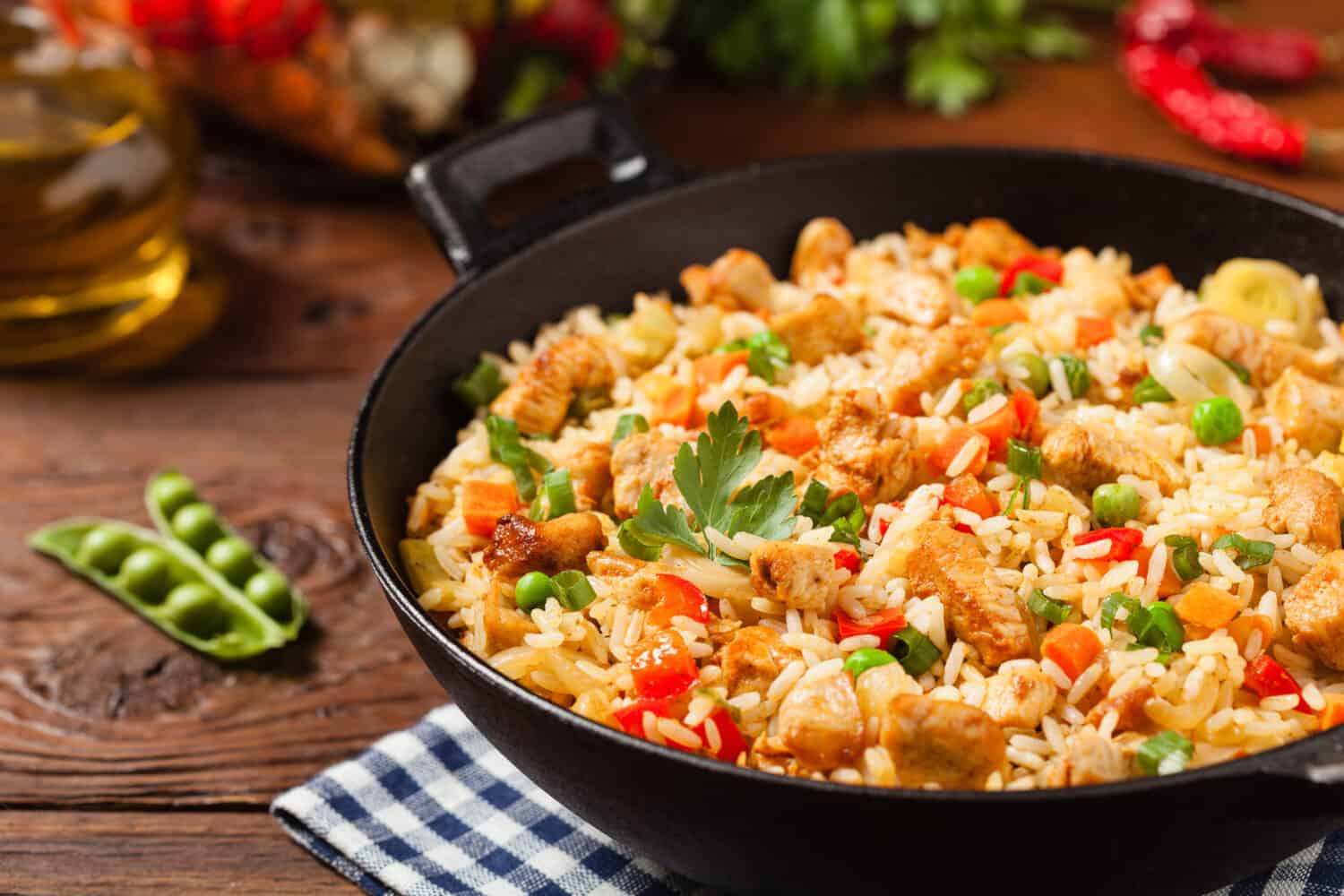Who doesn’t love this delicious Asian and Middle Eastern fried rice? Fried rice is one of the best ways to use up leftover rice and create a quick and easy weekday meal or a BBQ side dish. It, of course, contains rice and often protein such as pork, shrimp, chicken, beef, tofu, and vegetables. Fried rice is so versatile that it can complement any meal. However, there is a debate as to whether fried rice is healthy. In this article, we explore the origins, versatility, nutritional information, health benefits, and ways to create a healthy fried rice dish. Read on to learn more!

©StockImageFactory.com/Shutterstock.com
History of Fried Rice
In China, during 589-618 AD the Sui dynasty was the earliest recording of fried rice. However, the first stir-frying method was noted much earlier. Later, through the late Ming dynasty during 1368-1644 AD, stir-frying became popular. It is said that fried rice originated as a way to use leftover rice from the day before and add meat, vegetables, soy sauce, garlic, and lard to the dish to make a hot flavorful dinner. Fried rice is a popular dish in some South Asian, East Asian, and Southeast Asian cuisines and is a staple dish in Indonesia. Furthermore, it has gained popularity throughout the rest of the world. This is because it is a versatile and affordable dish for many households.
What is Fried Rice?
Fried rice is rice that has already been cooked, it is then stir-fried in a frying pan or wok and has other ingredients added to it such as meat, vegetables, seafood, and eggs. It can be a dish enjoyed on its own or added as a side dish to roasts, BBQ, and more. Fried rice is quite diverse however, certain dishes require their own distinct ingredients.
Furthermore, in Japan, chāhan is believed to be a Japanese-Chinese dish. Chāhan is cooked by stir-frying the ingredients in a wok. Cooked rice is the main ingredient and numerous supplementary components such as shiitake which is an edible mushroom native to East Asia, vegetables, garlic, onion, pork, tofu, scrambled egg, salmon, roe, crab meat, octopus, and more. Oils such as sesame, sunflower, and olive oil are used when frying to add that extra richness. These dishes are often seasoned with katsuobushi which is flaked dried tuna, soy sauce, salt, oyster sauce, pepper, and sesame oil. Edible seaweed known as Nori is often used as garnish in Japanese fried rice.
Is Fried Rice Healthy?
When you first look at fried rice you see a healthy, tasty, colorful dish filled with vegetables, meats, or seafood. However, looks can be deceiving with too much soy sauce that can be high in sodium, oils, and MSGs these meals can be unhealthy and high in calories, and fat and should be eaten in moderation. To add, you can still enjoy this dish and make it healthy. Let’s dive into fried rice, the different types of rice, the calories involved, and how you can enjoy this dish in alternative ways.
Calories and Nutrients in Fried Rice
When preparing fried rice you should consider the nutrients involved. Fired rice is typically higher in calories because of its oil and soy sauce content. However, did you know that there are over 40,000 types of rice? I’m surprised too, and each one contains different nutritional values which we will discuss below.
Plain-fried white rice is usually cooked using a wok or fry pan and contains vegetable oil and no other ingredients. One cup has approximately 706 mg of sodium which is almost one-third of the recommended daily intake for for an adult. It also contains 41 grams of carbohydrates. Your daily intake of carbohydrates should be between 225 and 325 grams per day. One cup of fried white rice contains 242 calories and 8 grams of fat.
Using whole grains such as brown rice and lean proteins such as chicken breasts, shrimp, eggs, and a variety of vegetables can help improve the nutritional value of fried rice.
Cauliflower rice is another healthy option, and it is super easy to make. Cauliflower is a good source of folate which is important during pregnancy as it supports cell growth. It is also high in vitamin K and C and low in calories. One cup of cauliflower has 5 grams of carbohydrates and only 25 calories.
How To Make Cauliflower Rice
Cauliflower rice is the perfect substitute for white or brown rice and only takes 5 minutes to prepare. It is vegan-friendly and gluten-free and can be frozen uncooked for up to one month.
Ingredients
- 1x cauliflower head
- 1 tablespoon of oil
Directions
- First, wash and dry the cauliflower and remove the green.
- You can either use a cheese grater or a food processor with a grater attachment to grate it into rice.
- Next, heat a skillet and add the tablespoon of oil, sauté the cauliflower, and cover with a lid for 5-8 minutes season with salt and pepper. Serve and enjoy.
What are the Benefits of Fried Rice
- As previously mentioned fried rice is high in calories, and it often contains a good source of vitamins and minerals. However, for a healthier alternative brown rice should be considered first, this is because it is an excellent source of B vitamins and minerals, manganese, magnesium, and fiber as well as containing phenols and flavonoids which are two beneficial antioxidants that reduce the risk of early aging and damage to cells within the body.
- Studies have shown that eating whole grains three times per day can lower the risk of type 2 diabetes by 32%. One of the advantages of brown rice is that it has a low GI (glycemic index) that prevents blood sugar levels from rising contains fewer calories than white rice and helps you feel fuller for longer.
Conclusion
Fried rice can be associated with unhealthy eating habits however, it can still be enjoyed in moderation. It is best to opt for brown rice, choose lean meats, and add plenty of colorful vegetables such as bell peppers, broccoli, and carrots also reduce the amount of oils and soy sauce. By doing this you can still enjoy fried rice and maintain a healthy balanced diet.
Recipe Card for Fried Rice
Try this tasty fried rice dish for your next dinner. Enjoy!
Print
Healthy Fried Rice
- Yield: 10 servings 1x
Ingredients
- 1 1/2 cups water
- 1 cup chicken stock or broth
- 1 1/3 cups long-grain white rice, uncooked
- 2 teaspoons vegetable oil
- 2 Tablespoons onion, finely chopped
- 1 cup celery, finely chopped
- 2 Tablespoons green pepper, finely chopped
- 1/2 cup pecans, chopped
- 1/4 teaspoon ground sage
- 1/2 cup water chestnuts, sliced
- 1/4 teaspoon nutmeg
- Black pepper to taste
Instructions
- Bring water and stock to a boil in a medium-sized saucepan.
- Add rice and stir. Cover and simmer for 20 minutes.
- Remove the pan from heat. Let stand, covered, for 5 minutes or until all liquid is absorbed. Reserve.
- Heat oil in a large nonstick skillet.
- Sauté onion and celery over moderate heat for 3 minutes.
- Stir in the remaining ingredients, including reserved cooked rice.
- Fluff with a fork before serving.
Nutrition
- Serving Size: 1/2 cup
- Calories: 139
- Sodium: 86 mg
- Fat: 5 g
- Carbohydrates: 21 g
- Fiber: 1 g
- Protein: 3 g
- Cholesterol: 0 mg
The image featured at the top of this post is ©gkrphoto/Shutterstock.com.


